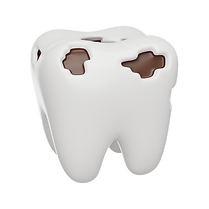What is tooth decay?
Tooth decay is a degenerative disease of dental hard tissues (enamel and dentin) that originates from the surface and grows deep into the tooth pulp. Caries does not give major symptoms until the advanced stage, when the tooth begins to hurt.
It is prevention that is the first treatment for caries.
Caries arises from the disruption of the balance of the bacterial flora normally present in the mouth. The bacteria in plaque use sugars from food to survive and at the same time produce acidic waste substances, which are capable of causing injury to tooth enamel. If plaque is not carefully removed, these lesions, initially reversible, can evolve to generate a cavity in the tooth.

Cause
Bacteria present in the mouth.
Sugars.
Genetic predisposition.
Care
Fillings.
Inlays on permanent teeth.
Conscious sedation with the mask of courage
Treating tooth decay painlessly.
Prevention
Sealing.
Hygiene sessions.
Symptoms of tooth decay
Usually caries does not cause symptoms and can only be diagnosed during a checkup.
Symptoms begin to appear in the advanced stage, when the caries reaches the pulp, causing structural destruction of a portion of the tooth.
Symptoms may be:
pulsating, sharp pain;
pain on chewing;
pain caused upon eating sweet, very hot or very cold foods.
Sometimes, it is possible to notice for oneself the signs of caries on the teeth, especially on the front teeth, which are more accessible and easy to see, such as: holes, brown or black spots.
The causes of tooth decay
A number of factors must coexist for caries to develop:
presence of bacteria capable of producing acids that alter tooth structure;
availability of sugars in the diet that promote bacterial growth and adhesion;
genetic factors that erode tooth strength and promote bacterial growth;
the quality of the tooth;
the shape of the tooth and arch;
the characteristics of saliva.

Preventing tooth decay with sealants
Sealants
Sealing is a dental treatment that prevents caries. It is generally performed on permanent molars, the teeth most at risk because they present deep grooves and are the most difficult to clean well with a toothbrush. We use specific non-toxic resins for sealings.
Why perform a sealant?
It is a quick and painless treatment, a good ally for preventing tooth decay in the future.
How is the sealing performed?
Sealing is quick, simple and painless. It starts with a deep cleaning of the grooves of the permanent molars. Then a deep cleansing with a blue paste and, finally, varnishing with a liquid resin, the sealant.
What is the durability of the sealant?
A good sealant done properly provides protection from caries for many years, and if the sealant becomes damaged, the procedure can be repeated.

The stages of the pathway
The visit
During the first visit, the pedodontist searches for holes in the enamel using a sharp probe. If during the probing of the furrows the probe becomes blocked, there is confirmation of dentin softening. Technological confirmation is then made through the use of radiographs.

1
Caries prevention
Good prevention is the first step in avoiding cavities.
We recommend:
brush your teeth with a fluoride toothpaste at least twice a day, preferably after every meal;
reduce foods and drinks with sugars and starchy foods;
floss daily to remove food debris and plaque;
make regular checkups twice a year;
seal permanent molars to protect the chewing surfaces of the teeth;
regular dental hygiene sessions.

3
The treatment of caries
Dental filling is performed, restoring tooth structure, morphology and integrity. It is a painless treatment, thanks to the use of conscious sedation, which helps the child relax and cooperate with his or her pedodontist.

2
Clinical cases
Our Services
From our Blog
They say about us.
Oct 28, 2021
Nicole A.
Ci tornerò sicuramente!
Ambiente accogliente, pulito e team professionale, specializzato e preparato. La tecnologia del laser, che non conoscevo, è una cosa pazzesca: mi è stata curata la carie ed io non ho sentito nulla. Prezzo giusto per il servizio. Ci tornerò sicuramente!
Nov 3, 2022
Daniela N.
Ottimo servizio
Denti brillanti e personale gentile.. davvero un buona esperienza. Grazie!!
May 3, 2022
Maurizia L.
Andriolo sempre una garanzia
Da anni mi affido ad Andriolo per la cura dei denti di tutta la mia famiglia... professionali, disponibili, prezzi giusti... non li cambierei mai!
















